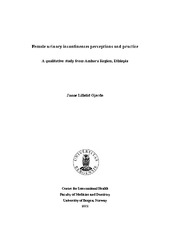| dc.description.abstract | The current study aims to add in-depth knowledge of how women living in rural and semiurban areas of Northwest Ethiopia perceive and practically handle urinary incontinence. In several high-income settings, female urinary incontinence has been found to affect one in four women, and has been related to diverse reproductive health related factors, as well as to age and hard physical work. The experience of involuntary leakage of urine is found to severely influence physical, psychosocial and social well-being, and has also been found to have an economic impact on those who are affected. Perceptions and the handling of ill health conditions commonly differ considerably based on the socioeconomic and cultural context within which it is experienced. Limited research based knowledge is available on the experience of living with urinary incontinence in low-income contexts. Due to perceived challenges with limited access to water, to essential remedies and to health care services, the implications of urinary incontinence are thought to considerably differ from the ones experienced in more affluent settings. The study was conducted in the North-Gondar zone of Amhara Region in Ethiopia in 2011, and included 26 informants; women suffering from urinary incontinence, health workers, a traditional healer and relatives of the women suffering from urinary incontinence. A qualitative approach was employed with in-depth interviews as the main data collection method. Informal talk with large numbers of individuals about the topic added important knowledge to the material. In the analyses of the data material ‘Systematic Text Condensation’ framework was applied. The findings of the study illustrate how socio-cultural as well as practical and economical circumstances strongly influence on how the women perceive and handle the leakage. Limited access to water, soap, pads and spare clothes characterized the daily management of the problem. Shame, embarrassment and fear of being discriminated led to substantial efforts to hide the leakage. A majority of the women related the leakage to childbirth. Others held socio-cultural related explanations responsible. Although most of the women had been in contact with the health system, they usually did not seek help for or disclose the urinary leakage to health personnel. Religious or other ‘traditional’ remedies were frequently sought, although disclosure of the leakage rarely took place also in such settings. The discussion briefly draws upon cultural- and critical theoretical approaches in medical anthropology to make sense of the study findings. The thesis is based upon the current guidelines provided by the Centre for International Health, University of Bergen. The format chosen for the current study is the combination of an introductory thesis, followed by a paper presenting the findings of the study. The paper was published by the International Urogynecology Journal in 2013: https://doi.org/10.1007/s00192-012-1951-4 | en_US |
